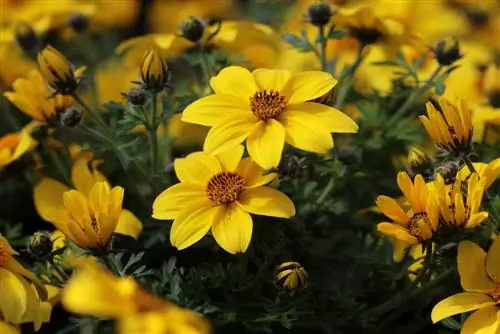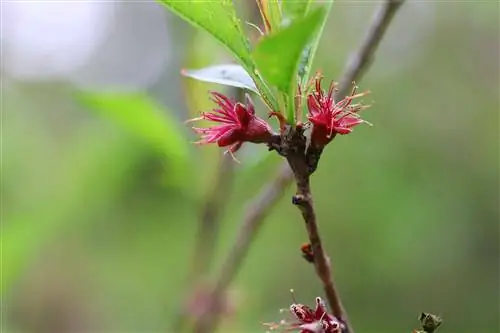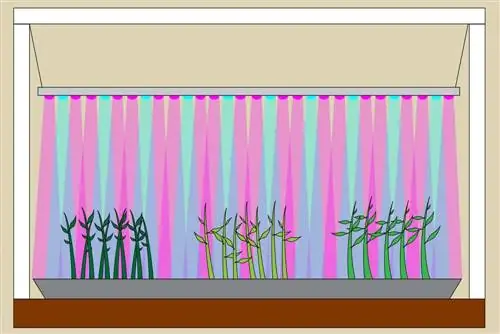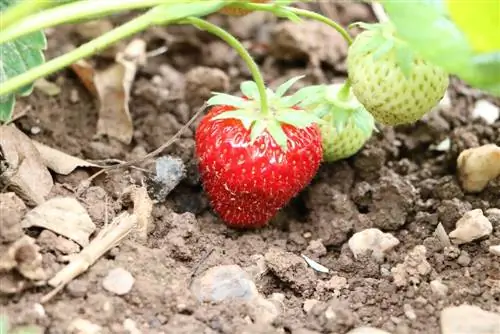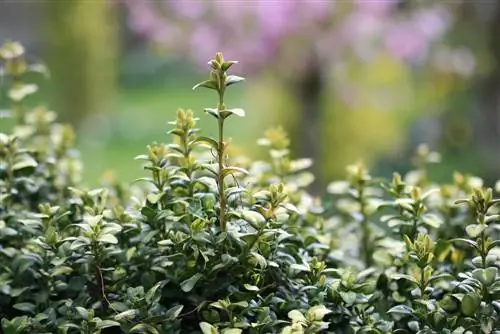- Author admin [email protected].
- Public 2023-12-17 03:39.
- Last modified 2025-01-24 12:45.
The Goldmarie Bidens ferulifolia is an herbaceous plant with colorful yellow inflorescences and fine, elongated and strongly slit leaves. Due to its dense summer green foliage, it is often used as a decorative ornamental plant. The Goldmarie is colloquially referred to as Goldkosmos or Goldfeber. The botanical name of the Bidens (two-tooth) comes from the fruits of the plant. They attach themselves to the fur of animals and clothing with their barbs and thus reach new habitats. Bidens ferulifolia is a grateful summer flower that requires minimal care.
Soil/Location
In order for Bidens ferulifolia to grow well, it needs well-drained soil. It should have enough nutrients. Improving the soil with sand or gravel and humus and a pH value between 5 and 6 have a positive effect on the growth of the Goldkosmos plant, because the Bidens originally comes from Mexico, where it grows in the wild among field plants. Goldmarie produces the most flowers in a warm, sunny location. However, it also tolerates partial shade and shade, although a shady location can have an unfavorable effect on the abundance of flowers and produces more green foliage that forms a dense carpet. The Goldmarie with its overhanging growth is often used for balcony boxes, hanging baskets, borders and waysides. It grows well in rock gardens and planters. The Goldkosmos plant is suitable for planting under standard trees and has recently been offered as a standard tree itself.
Plants
The Goldmarie grows between 30 and 60 cm high and continually develops new flowers between early summer and autumn, which attract many insects, bees and bumblebees with their slightly sweet scent. In the bed and on the edges of the path, the planting distance should be around 30 cm so that the Bidens can develop well. Around nine plants can be planted per square meter. The planting depth for the young seedlings is 10 to 12 cm. A shady day is an advantage for planting so that the Goldmarie can acclimate well. A partially shaded spot is appropriate until the seedlings have grown.
Pouring
The soil should never dry out completely, although waterlogging is not tolerated. In midsummer, the busy, perennial bloomer can be watered in the morning and evening.
Tip:
The Goldmarie drops its flowers due to waterlogging or a dry root ball! By the way: Water is urgently needed, especially when the shoots hang limply.
Fertilize
The nutrient requirement is high because the Goldmarie continually produces new shoots with flowers and leaves. The first fertilizer applications should only be made when the perennial has grown properly. In the main season, in June, July, August and September, weekly fertilization with commercially available liquid fertilizer is advantageous. With less fertilizer, the two-tooth does not grow as luxuriantly. However, even in rainy summers, it reliably produces many small yellow flowers that look like little suns.
Cutting
Bidens ferulifolia generally does not need to be cut if rapid and voluminous growth is desired. There is no need to cut off what has faded. It will simply be overgrown by new shoots and later fall off on its own. Bidens don't self-seed. If the spent flowers are removed, new flowers will quickly form. If the Bidens ferulifolia spreads too much, it can of course be cut back as necessary.
Tip:
Removing the shoot tips in spring ensures bushier growth! Pruning in July/August extends the flowering period.
Wintering
Overwintering is not worth it if new cuttings were taken from the mother plant in autumn. However, if Bidens ferulifolia grows in planters, a bright, frost-free winter location between 5 °C and 10 °C is necessary. The two-tooth is only watered sporadically in winter quarters. The root ball should not dry out completely. Because of its strong roots, it needs new planting substrate and a larger planting container in spring. Commercially available potting soil is completely sufficient for this. By the way: At the end of the wintering period, the Goldmarie can be watered again.
Tip:
For abundant new growth, the gold tooth is only cut back in spring!
Propagate by seeds
Bidens ferulifolia can be propagated by seeds or cuttings. This is more common instead of overwintering. For sowing, the seeds are collected from the withered flowers in autumn and sown under glass in January to February for early flowering. It is still possible to sow seeds in March. The seeds are distributed widely over the potting soil and lightly covered with soil. The germination time is around two weeks. During this time, the soil must be kept slightly moist at room temperature.
Propagation by cuttings
- Cut cuttings in early fall
- plant in growing substrate
- keep slightly moist
- Do not place in direct sunlight until the roots have formed
- Overwinter young plants brightly and frost-free and plant them outdoors in the spring after the Ice Saints
Tip:
Do not expose young plants to the midday sun! This is not a problem with older plants.
Potential diseases and pests
- Aphids
- red spider
- Thrips
They are controlled with commercially available insecticides.
Tip:
A species-appropriate location makes Bidens ferulifolia more resistant to diseases and plant pests!
Decorative species
- Bidens gardeneri with orange flowers
- Bidens ferulifolia Goldilocks Rocks with bright yellow flowers
- Bidens pilosus with white flowers and yellow flower center
- Biden's Orange Drop with yellow flower center and organ yellow petals with yellow leaf tip
- Biden's Red Drop with scarlet flowers
- Biden's Belamy White with white flowers and dark green leaves
Frequently asked questions
What sets Goldmarie apart?
It is extremely flowering and quickly forms dense posters.
Which plant neighbors are decorative?
The rapidly growing broom quickly overgrows all of its neighboring plants. Fast-growing plant partners are therefore a must. Fast-growing zonal pelargoniums, hanging petunias and verbenas are recommended for the balcony box. Summer flowers with red or blue flowers bring variety to perennial beds.
How does Goldmarie work best?
It is a very decorative solitary plant.
How many two teeth fit in a hanging basket or balcony box?
For dense vegetation, two or three plants per hanging basket are recommended. Four plants fit in the flower box.
How long do the hanging shoots of the Goldkosmos plant get?
They can grow up to 80 cm long.
What you should know about Goldmarie in brief
- Goldmarie loves the blazing sun, but can also cope with a little shade.
- The demands on the earth are low. Normal garden soil is completely sufficient.
- The plants have a very high nutrient requirement. They need to be watered and fertilized regularly.
- Fertilizing twice a week allows Goldmarie to grow and bloom luxuriantly.
- The plant should never dry out completely, but waterlogging is just as damaging.
Wintering
The Goldmarie can be overwintered with a little skill. Before that, the crown should be cut back to about a third of the existing leaf mass. The ideal place to overwinter is bright and cool, at 5 to 10 °C. Dark rooms are not suitable. In spring you cut the plant back again.
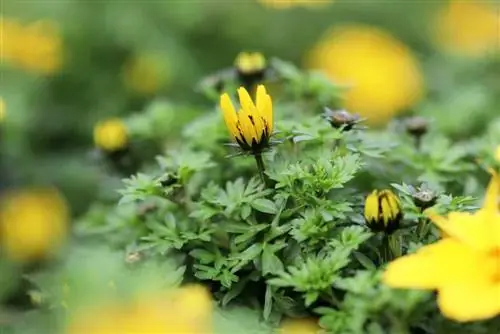
After one to two years, repot the plant in spring. The container should be slightly, but not much, larger. It is favorable if the new soil contains around 30 percent mineral components such as clay, loam, sand, tuff, volcanic components or expanded clay.
Propagate
Goldmarie is propagated by sowing between January and March. The soil should be kept evenly moist and not allowed to dry out. The germination period is 12 to 18 days. 20°C is the ideal temperature. Planting the seedlings is possible after the Ice Saints. Propagation via cuttings can also be attempted. Both head cuttings and partial cuttings are possible. If possible, plant two cuttings together to get a beautiful bushy plant.
- If you cut the tips every two weeks in April and May, the plant will become a mass bloomer.
- Whiteflies, leaf miners and thrips can occur as pests.

